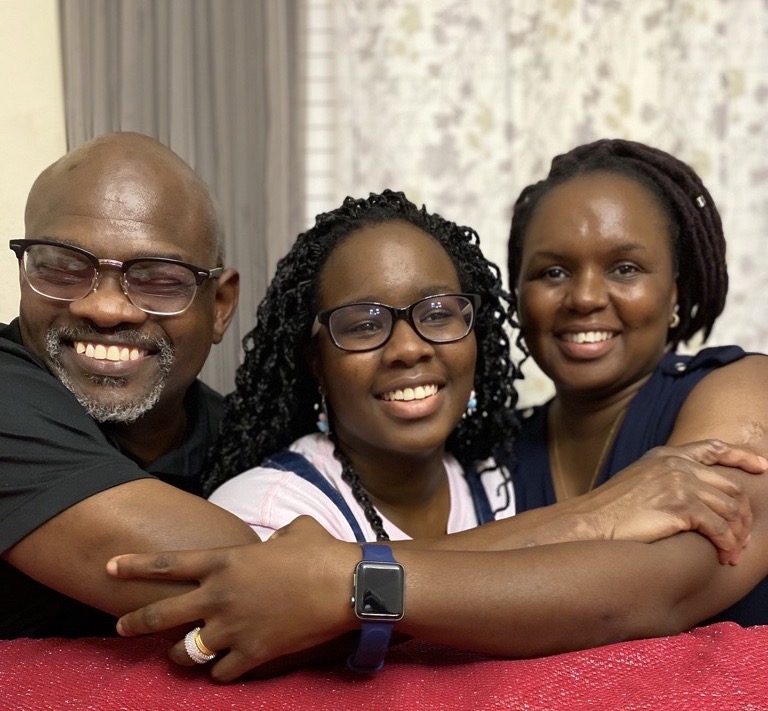Vaccine inequality struck international family members of CVHS students and staff
Disparities in medical resources and vaccinations distributions in countries outside of the US have negatively impacted families of CVHS students and staff.
Photo courtesy of Barbara Butali
CVHS junior Barbara Butali and her parents warmly embrace as they celebrate their fully vaccinated status as of February 2021. (Photo courtesy of Barbara Butali)
October 1, 2021
Just last Friday on September 16, 2021, the FDA Vaccine Advisory Committee rejected President Biden’s booster shot plan for the general population amidst growing criticism of vaccine disparity, including a call by the World Health Organization (WHO) for a moratorium or ban on booster shots until poorer countries are able to provide the first dose of vaccines for their populations. As of September 9th, only 2% of the population in low-income countries had received at least one vaccine dose, compared to 30% in lower-middle-income countries, 54% in upper-middle-income countries, and nearly two-thirds (65%) in high-income countries, according to a report by the Kaiser Family Foundation. Meanwhile, four national pharmacy chains reported more than 1 million wasted doses each, according to data released Tuesday by the Centers for Disease Control and Prevention in response to a public records request.
While CVHS students and faculty may already have an opportunity for a third booster shot, their family and friends in their home country outside of America still struggle with vaccine disparity.
Through the course of the pandemic in South Asia, India was involved in vaccine production similar to the United States by contract manufacturing from Johnson & Johnson, who controlled their exports according to Democracy Now. Rather than prioritizing vaccine distribution within the country’s population first, India exported their vaccines to wealthier nations under Johnson & Johnson’s order. According to The New York Times, less than 15% of the population in India has been fully vaccinated, correspondingly having about 307 deaths per 100,000 residents within the country as of September 2021.
CVHS geometry teacher Sanjog Kulkarni worries about his relatives and friends currently living in India. Besides a few distant relatives contracting COVID, Kulkarni describes his family members as part of the average class in India and were not severely impacted by the disparities within vaccine distributions in comparison to those of the poorer demographic. Friends of Kulkarni, on the other hand, have been severely impacted by COVID due to India’s lack of vaccines and medical facilities.
“They’ve been through terrible phases, and a few of my friends lost their lives, which is terrible,” said Kulkarni.
Although these disparities remain prominent within India, Kulkarni’s immediate family, including his parents and relatives, have been fully vaccinated.
Presently in central cities of Vietnam, vaccinations have been prioritized to begin a plan of reopening cities, although there has been a significant struggle to distribute full doses due to shortages in supply. According to NPR, 95% of residents were unable to receive their second vaccine in Ho Chi Minh City. In addition, The New York Times has recorded that 6.8% of the population in Vietnam has been fully vaccinated, and approximately 228 deaths per 100,000 residents currently stand in September 2021.
CVHS junior Sidney Nhu Nguyen is impacted by Vietnam’s disparities through an abundance of family members that live there, at least 20 total.
“I heard through phone calls with them about how the cases keep rising and Saigon shut down,” said Nguyen.
Nguyen’s family has been facing these detriments head on, as they also find difficulty in attaining vaccines due to the constant shortages that arise in Vietnam.
“In Vietnam, they actually don’t have a lot of vaccines and those who do get their hands on the vaccine are mainly the rich people. So, all my family members and a lot of other people in Vietnam are not vaccinated yet,” said Nguyen.
Not only are poorer countries facing a shortage of vaccines, but they are also facing a shortage of masks, oxygen tanks, and medical workers. 17% of the world’s population inhabits Africa, but Africa only accounts for a little more than 3.48% of COVID-19 cases, and an almost identical amount of deaths, worldwide. According to The New York Times’ Covid World Vaccination Tracker, Kenya’s vaccination rate is increasing in momentum but is still sparse at 3.4 million doses, covering only 6.5% of the population. (For comparison, that of Vietnam is 35%, India is 60%, and the United States is a whopping 117%.)
This has forced 25 people in CVHS junior Barbara Butali’s Kenyan clan to go through isolation, sickness, and for some, death, causing Butali to become physically and emotionally disconnected from family members.
“There have been a handful of online Zoom funerals, and our elderly people getting sick and passing away—those have hit my family the hardest,” stated Butali.
With mounting criticisms to address vaccine inequality, during a virtual global vaccine summit of world leaders just this past week, President Biden pledged to donate an additional 500 million Pfizer vaccine doses to other nations around the world. Biden made the pledge during a virtual global vaccine summit of world leaders and called on wealthy nations to vaccinate 70% of the world’s 8 billion people within the next year.
“If anything, I’d like for people to understand just how privileged they are [here in the United States],” concluded Butali.
This story was originally published on Upstream News on September 28, 2021.




































